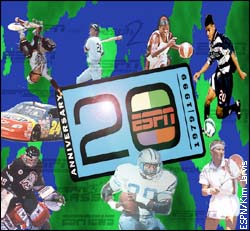 |
|
| | Monday, September 6 | |||||
| With ESPN's 20th anniversary approaching on September 7, the following FAQ --"frequently asked questions" -- may be useful to you. ESPN will present a three-hour 20th anniversary special September 7 at 7 p.m. ET.
Q: What does ESPN stand for?
Q: Why Bristol? A: Why not? Actually, the story is amazingly simple. Bill Rasmussen, who had been public relations director of the World Hockey Association New England Whalers, had the idea for a sports network for Connecticut. Rasmussen lived in nearby Avon, Conn., a Hartford suburb, and was renting a 20x20 room within the Plainville offices of United Cable, the local cable company. At the time, cable systems were beginning to switch from receiving signals via microwave to using satellite dishes. The town of Plainville had an ordinance against them so Jim Dovey, the local United Cable vice president, inquired about some land for sale in the adjacent town of Bristol. There were four one-acre parcels for sale on the edge of town in an industrial park. Dovey only needed a small part of one parcel and bought it. Knowing Rasmussen would soon need to find a piece of property for his television production facility, Dovey suggested Rasmussen call Bristol town officials. He did, and that day negotiated a price for the remainder of "Parcel A" -- $18,000 -- sight unseen. Despite the lack of a thorough site survey and review of other properties, it was a fortuitous selection, as Rasmussen explains: "When the folks from Scientific Atlanta (provider of satellite earth stations) visited, they were very impressed with our choice! The ridge rising to the west of us (South Mountain) provides a perfect shield from the interference of telco airwaves travelling from New York to New England. And yet, if the mountain was any higher, it would be too high, blocking our signal heading to the satellite transponder! They thought we were brilliant; it was blind luck!" The choice suited ESPN's purposes just fine then, and today as well -- with the addition of Parcels B, C and D, 16 more acres on the current ESPN Plaza and a new "East Campus" being developed on 23 acres across the street. Q: Who was the first person and what were the first words spoken on ESPN? A: Lee Leonard said, "If you're a fan, if you're a fan, what you'll see in the next minutes, hours and days to follow may convince you you've gone to sports heaven." After a hokey ESPN theme song set to sports footage, Leonard appeared on camera and said, "Yea, verily, a sampler of wonders." Q: What was the first night's programming?
A: Q: What was the first commercial? A: Budweiser, complete with Ed McMahon's voice and the Clydesdales. Q: Weren't Chris Berman, Bob Ley and Tom Mees on the first show? A: No. Ley started two days later, September 9. Mees began at ESPN on September 17 and Berman on October 1. Q: Then who are the ESPN commentators with the longest tenure? A: Aside from Ley and Berman, Cliff Drysdale has worked for ESPN since the network's first tennis telecast, Argentina vs. the U.S. in a live Davis Cup telecast on September 14, 1979. Bob Jenkins had already taped some auto races, but they weren't aired until later in the fall (first was on October 7). Also, Dick Vitale worked ESPN's first NCAA basketball game, Wisconsin at DePaul on Dec. 5, 1979. Q: How many employees did ESPN have then and how many are there now? A: There were about 70 at ESPN when the network debuted and more than 2,100 today, including 14 originals. Also, it's interesting to note that today ESPN has as many employees in Argentina (70) as there were with the company at launch. Q: Do all television productions come from Bristol? A: Almost. Up Close emanates from Los Angeles, The Sports Reporters is done in a New York studio and on weekdays ESPN2's RPM 2Night is produced in a studio near Charlotte. But each of the 21,000-plus SportsCenters have come from Bristol. Q: What was the company's "turning point," the sign it had made the "big time"? A: Depends on whom you ask. The NCAA Tournament in March 1980 was the first event that brought significant national attention to the fledgling outfit, followed a month later by the NFL Draft. Some point to the debut of live college football in 1984 while others cite 1987, when the America's Cup from Australia in February helped convince the NFL to give ESPN the league's first cable contract for games that fall. Q: What are Chris Berman and Dick Vitale really like?
A: What you see is what you get!
| ||||||

